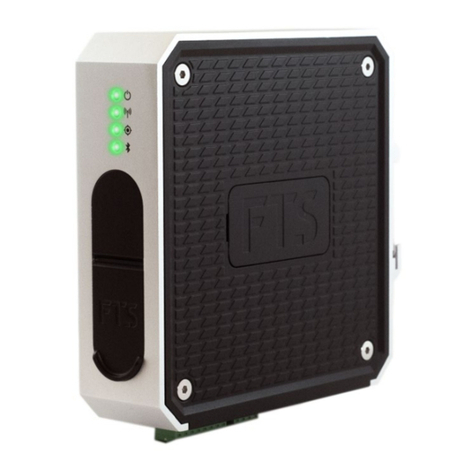
LT1 FIELD QUICK START GUIDE
FOR ALL LT1 CELLULAR AND SATELLITE VARIANTS
700-LT1-QS Rev. 4 09 Feb 2021 Service and support: http://support.ftsinc.com Toll free: 1-800-548-4264 1/2
Part #: 19682
This guide is meant as a ready reference to set up an LT1 station in
the field. Details of station setup can be found on the FTS Support
website (http://support.ftsinc.com/) in the following manuals:
•LT1 Operator’s Manual (700-LT1- Man).
•FTS360 and FTS360 Config App User Manual (700-FTS360- Man)
IMPORTANT! Prior to proceeding to the field the
following MUST be completed
THE FTS 360 ADMINISTRATOR MUST:
Initialize (https://360.ftsinc.com/signup) or login to FTS360
Create a Technician account for the field technician
Ensure any SDI-12 sensors to be added in the field exist in
the sensor library (either default or custom sensor)
THE FIELD TECHNICIAN MUST:
Be invited to join FTS360 by administrator
Download the FTS360 Config App onto the device that will be
used in the field (iOS, Android or Windows)2
CELL only: Provision the SIM card and test the LT1..
Ensure the APN for the SIM card is entered (Go to the FTS
Config App’s dashboard and select “Cellular”)
GOES: Bring satellite assignment information ( NESDIS ID,
channel, baud rate, transmission time)
Log onto the FTS360 Config App, synchronize with FTS360
(section B step 4). DO NOT LOG OUT
Ensure the SD Card is inserted.
Ensure any SDI-12 sensors to be added in the field exist in
the sensor library
1 - Refer to the LT1 Operator’s Manual (700-LT1 Man) for details on testing the LT1
2 –Download at
Cellular APNs
LT1 PARTS
Also included:
•FTS approved industrial 4G SD card (inserted)
•3/32” (2.4mm) slot screw driver
•GPS/Cellular antenna (CELL only)
•GPS antenna for LT1-GOES (if LT1-GOES-GPS-BNDL ordered)
•SMA male to N female adaptor (GOES only)
Optional Items:
•Activated SIM card (inserted) if FTS cellular plan purchased
•
A. INSTALLING THE LT1
1. You will need:
•Combined GPS/cellular antenna or GPS and satellite antennas
•Antenna mounts (GPS/Cellular/Satellite
•Weatherproof (IP66) enclosure with 35mm x 7.5mm DIN rail
and grounding lug
•12VDC sealed lead acid battery
•Earth-ground system
•16 AWG - 28 AWG copper wire (for earth-ground system)
•2 spools 16-28 AWG wire (for positive and negative power
connections)
•Wire cutters and strippers
•Tools/hardware to mount enclosure and antenna
2. Connect telemetry
a) Mount the antenna(s) in the desired position
b) Connect the antenna leads to their respective connectors on
the LT1 (use SMA to N adapter as required)
3. Mount the LT1
IMPORTANT! The LT1 MUST be mounted in a weatherproof
enclosure. Exposure to rain greater than 1mm per hour or
spray may cause the unit to fail.
•Mount the LT1 onto the 35mm x 7.5mm DIN rail
4. Ground the system
FTS recommends that you consult a qualified professional to ensure
adequate earth ground protection is installed for the site and that all
local regulations and requirements are met
Connect a 16 to 28 AWG wire to the CG pin and attach the running
end to the enclosure’s grounding lug. Complete the earth
ground system in accordance with its design.
5. Connect power
IMPORTANT! If using a solar panel and regulator, follow the
manufacturer’s directions to prevent system damage.
Direct to Battery: Follow the connection sequence to prevent
damage to the system.
(for use with FT742 heated anemometer)
Port Access
(Cell only)
Status
•SD card
•Micro-B USB
provided SIM
Terminal Blocks
•Data
•Power
GPS
Bell APN (Canada): wrmstatic.bell.ca.ioe
Verizon APN (USA): we01.vzwstatic
Rogers (Canada/USA):m2minternet.apn
Bell International (International): wrstat.bell.ca
Customer Provided SIM:_______________________________________




















